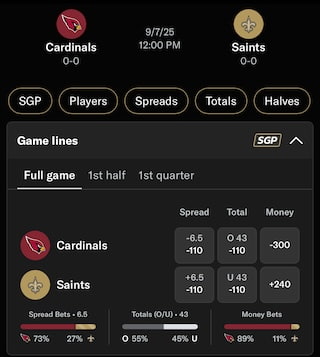You may have heard of the vig (also known as the “juice”) in sports betting. But what does the vig actually mean?
Our article will walk you through how the vig works in sports betting and how to calculate it using real-world examples.
What Is the Vig in Sports Betting?
The vig is the built-in commission or fee sportsbooks levy for taking bets. It's actually short for vigorish, but you may hear slang alternatives like the “juice” or “rake.” However you want to call it, the vig is how sportsbooks make money, no matter which side of a bet wins or loses.
You can think of the vigorish as a service charge that sportsbooks place on every bet. Sportsbooks bake this fee into betting lines and odds, so you don't immediately see it unless you know what to look for. For example, if you see odds of -110 on both sides of a point spread, the added price on top of even money (+100) is the vig.
Example of the Vig/Juice
The Arizona Cardinals are favored by 6.5 points (-110) on the spread in their NFL Week 1 matchup against the New Orleans Saints. You would need to successfully wager $110 on the Cardinals to receive $100 profit (on top of your stake).
If there were no vig, that same bet would be priced at even odds (-100). You’d earn a $100 win from a $100 bet on the Cardinals. However, sportsbooks inflate the line to get a cut from every bet (i.e., -110 odds instead of -100). The $10 extra you need to put down to win $100 goes to the sportsbook.

Is There a Difference Between the Juice and the Vig in Sports Betting?
The vig and the juice refer to the same thing in sports betting. You may hear the terms used interchangeably, and rightfully so (juice is slang for vigorish).
Some bettors (or even the actual sportsbooks) may use the “take” instead of vigorish and juice. They all refer to the price or cut sportsbooks take for accepting your bet. The most popular juice pegged on each side of a point spread bet is -110.
Key Question
Which Sportsbooks Don’t Have a Vig?
Unfortunately, every single sportsbook charges a vig. It's how sportsbooks cover operating costs and make a profit, no matter which side of a bet wins. The phrase “the house always wins” is also true in sports betting.
How to Calculate Vig/Juice in Sports Betting
In most cases, it's easy to spot the vig by looking at the odds. That's almost always true for total and spread bets where both sides typically have the same odds (read: -110). That means you must wager $1.10 to win $1, which translates to a $0.1 vig. Calculating the vig for other types of odds and lines isn't always as easy.
The step-by-step process for how to calculate vig/juice in sports betting goes as follows:
Step 1: Convert odds to implied probability
You can calculate implied probability using a different formula for positive odds and negative odds:
- For positive odds: 100 divided by (odds value + 100)
- For negative odds: Absolute odds value divided by (absolute odds value + 100)
Take the Detroit Lions (-140) vs. Green Bay Packers (+118):
- The Lions' implied probability would be 140 divided by (140 + 100) = 58.33%
- The Packers' implied probability would be 100 divided by (118 + 100) = 45.87%
Step 2: Add implied probabilities from both sides
In our Lions vs. Packers example, that would be 58.33% + 45.87% = 104.2%
Step 3: Minus 100% from the total to get the vig
In our example, the Vig would be 104.2% – 100% = 4.2%

How the Vig Works in NFL Betting
NFL point spreads typically use -110 odds on both sides. Let's say the Buffalo Bills are 3-point favorites over the Chicago Bears at -110 each. If we use the formula above, Bills -3 (-110) would come to an implied probability of 52.38%, and Bears +3 (-110) would have an implied probability of 52.38%. The vig will be 4.76%.
For NFL moneylines, the vig is based on how far off the favorite is from the underdog. A game between the Green Bay Packers (-180) and the Tampa Bay Buccaneers (+155) would have a lower vig of 3.51%.
How the Vig Works in Soccer Betting
Soccer betting includes three-way moneylines (win, lose, draw), and that makes calculating the vig more difficult. Let's calculate the vig of the upcoming Manchester United vs Chelsea match with odds of Man Utd +170, Draw +275, Chelsea +135:
- Man Utd win: 100 divided by (170 + 100) = 37.04% implied probability
- Draw: 100 divided by (275 + 100) = 26.67% implied probability
- Chelsea win: 100 divided by (135 + 100) = 42.55% implied probability
The vig would be total of 106.26% – 100% = 6.26% (juice)
For a simpler two-way soccer bet like Liverpool (-120) vs Manchester City (+105): Liverpool: 120 divided by (120 + 100) = 54.55% Man City: 100 divided by (105 + 100) = 48.78% Total: 103.33% Vig: 3.33%
How the Vig Works in Basketball Betting
NBA spreads work similarly to the NFL, with mostly standard -110 pricing. But let's look at the WNBA example of Indiana Fever (-115) vs Phoenix Mercury (-105):
- Fever: 115 divided by (115 + 100) = 53.49% implied probability
- Mercury: 105 divided by (105 + 100) = 48.78% implied probability
That means the Vig would be 2.27% (102.27% – 100%)
How Does Vigorish Impact Your Betting?
Since the juice is baked into lines, it must impact your bets. The vig pushes your break-even point past the normal 50% win rate. When offered -110 on point spreads, you must bag 52.38% of your bets just to break even. That ugly 2.38% is half the juice you're paying.
The higher the vig, the bigger its impact on your betting. At -115 odds, your break-even point rises to 53.48%, and it doesn’t help that the extra 3.48% is just half the vigorish. In fact, the table below shows how different odds affect how much you need to win to break even:
| Odds | Break-Even % | Profit on $100 Win |
| +100 | 50.00% | $100.00 |
| -105 | 51.22% | $95.24 |
| -110 | 52.38% | $90.91 |
| -115 | 53.49% | $86.96 |
| -120 | 54.55% | $83.33 |
How to Minimize the Impact of the Juice
While avoiding the vig completely is impossible, you can take steps to reduce its impact on your bottom line. Here are tips on how to minimize the sting of the vig:
- Shop around for the best betting lines: That gap between -110 and -109 may look small, but over hundreds of bets, it can make a significant difference to your betting balance.
- Avoid bets with a high vig: Futures, props, and parlays can have up to 30x the juice of moneyline and spread bets.
- Odds boosts can price out the vig: Taking advantage of odds boosts at sportsbooks can counteract the vig.
- Keep tabs on your win rates: This will tell you if you are beating the break-even cutoffs for your favorite odds and lines.
How to Use a No-Vig Calculator to Compare the Juice
A no-vig calculator removes the sportsbook's commission to show fair odds. This tool helps you identify which sportsbook offers the best value for a given bet.
- Enter the odds from different sportsbooks into the calculator.
- It will show you the actual probability of each outcome and what the odds would be without any vig.
- The sportsbook closest to fair odds has the best deal (lowest vigorish).
For example, if the fair odds on a game are -105 for both teams, but one sportsbook offers -108 while another offers -112, the first sportsbook is a no-brainer, since the vig is lower.
The Vig in Sports Betting | FAQs
How Does the Vig Work in Sports Betting?
The vig is a commission built into betting odds that guarantees sportsbooks' profit no matter the results. You can calculate it by converting odds to implied probabilities and finding the amount over 100%.
What Is Juice in Sports Betting?
Juice is another term for vig or vigorish. It refers to the same commission that sportsbooks charge on every bet you place.
What Does 20% Vig Mean?
A 20% vig would be extremely high for sports betting. This means that the sportsbook keeps 20% of all action.
What Is a Good Vig Percentage?
For standard spreads and totals, 4-5% vig (-110 odds) would be good, but something lower would be better for you. You should avoid any juice above 10%.

